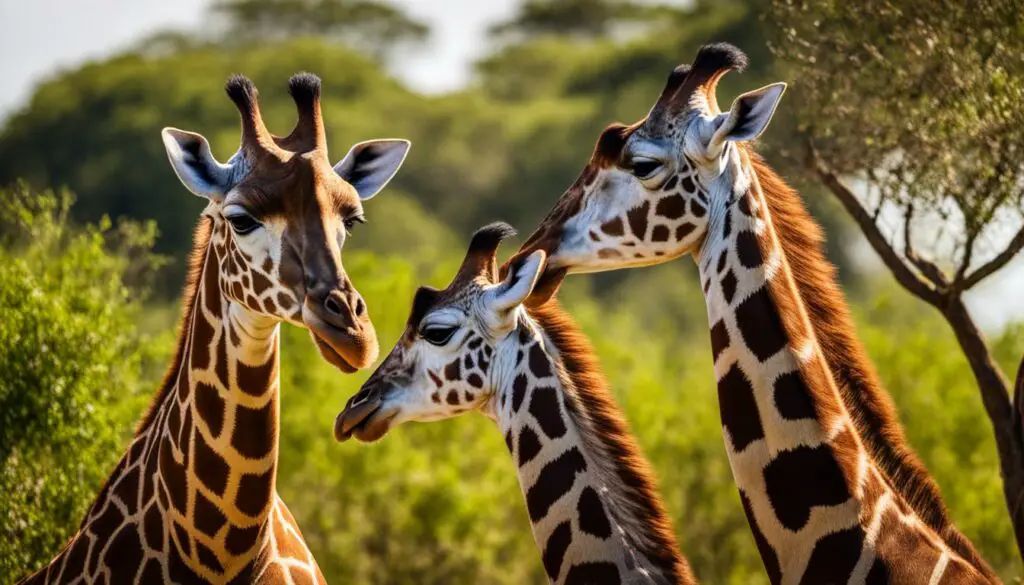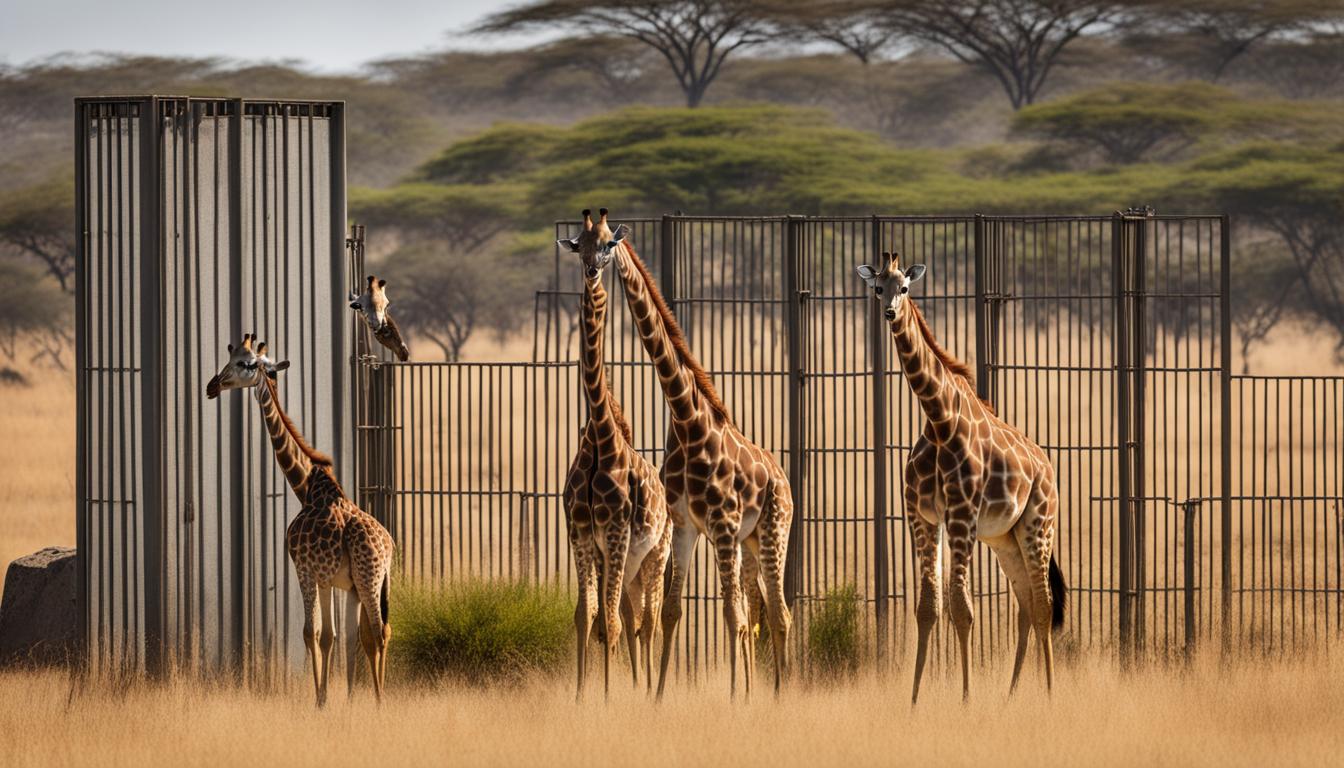Giraffes are fascinating creatures known for their distinctive appearance and graceful movements. But have you ever wondered how they behave in their natural habitat and in captivity? In this article, we will explore the various behaviors exhibited by giraffes, shedding light on their social interactions, feeding habits, mating rituals, communication methods, territorial instincts, group dynamics, herding behaviors, and foraging techniques.
Understanding giraffe behavior is essential for their conservation and well-being. By studying their behaviors, researchers can gain insights into their social structures, ecological roles, and survival strategies. It also helps inform management practices in captivity, ensuring that these majestic animals thrive in controlled environments. Furthermore, knowledge of giraffe behavior aids in conservation efforts in the wild, enabling us to protect their natural habitats and ensure their long-term survival.
Join us on this journey as we delve into the captivating world of giraffe behavior and discover the intricacies of their wild and captive lives. Get ready to be amazed by their social interactions, astonished by their feeding techniques, mesmerized by their mating rituals, fascinated by their communication methods, intrigued by their territorial instincts, awed by their group dynamics, inspired by their herding behaviors, and enlightened by their foraging techniques.
General Activities of Giraffes
Giraffes engage in various general activities that contribute to their daily routines and overall well-being. These activities include feeding, drinking, resting, and grooming.
Feeding: Giraffes primarily feed on leaves and twigs from different tree species. They use their long necks to reach foliage and strip leaves from branches using their lips and tongues. Feeding is a significant part of their daily routine.
Drinking: Although less common, giraffes do drink water. However, they obtain most of their hydration from the moisture in the leaves they consume.
Resting: Giraffes exhibit resting behaviors that involve lying down or standing in a relaxed position. They often rest in groups, which provides safety and protection against predators.
Grooming: Giraffes engage in grooming behaviors, which include licking their bodies, rubbing against trees, and scratching themselves with their horns. These behaviors help maintain cleanliness and contribute to their overall well-being.
| General Activities of Giraffes | |
|---|---|
| Feeding | Giraffes primarily feed on leaves and twigs from various tree species. |
| Drinking | Giraffes obtain most of their hydration from the moisture in the leaves they consume. |
| Resting | Giraffes exhibit resting behaviors by lying down or standing in a relaxed position, often in groups for safety. |
| Grooming | Giraffes groom themselves by licking their bodies, rubbing against trees, and scratching with their horns. |
Social Interactions Among Giraffes
Giraffes are highly social animals and live in herds consisting of both males and females of various ages. These herds play a crucial role in maintaining social structures and ensuring the safety of individual giraffes. Let’s explore the fascinating social interactions that take place among giraffes in their natural habitat.
One of the most prominent social behaviors exhibited by giraffes is necking, which involves two males competing for dominance. Necking is a display of strength and is often observed during mating seasons or when males need to establish their social hierarchy. During necking, the males swing their necks and deliver blows with their ossicones, which are the horn-like structures on their heads.
Courtship rituals are also a significant aspect of giraffe social interactions. These rituals include head rubbing, nuzzling, and vocalizations. Giraffes use these behaviors to communicate their interest in mating and establish a connection with potential partners. These courtship rituals can be observed between males and females as they engage in affectionate behaviors.
Giraffes also display remarkable coordination within their herds. Whether they are grazing or moving from one location to another, giraffes synchronize their movements to ensure safety and efficiency. This coordination is essential for accessing food sources, avoiding predators, and maintaining a cohesive social structure within the herd.
Table: Giraffe Social Interactions
| Social Behavior | Description |
|---|---|
| Necking | Competitive behavior between males to establish dominance |
| Courtship Rituals | Head rubbing, nuzzling, and vocalizations to initiate mating |
| Group Coordination | Synchronization of movements within the herd for safety and efficiency |
These social interactions among giraffes showcase the complexity and richness of their social lives. By understanding these behaviors, researchers can gain insights into giraffe communication, social structures, and their overall well-being. Studying and protecting these magnificent creatures is essential for the preservation of their natural habitats and the conservation of their species.
Giraffe Reproductive Behaviors
Giraffes engage in various reproductive behaviors to ensure successful mating and the continuation of their species. Understanding these behaviors is essential for conservation efforts and the management of giraffe populations. Let’s explore some of the key reproductive behaviors exhibited by giraffes.
Giraffe Mating Behavior
When it comes to mating, male giraffes compete for access to females. Dominant males often engage in necking behavior, a display of strength and dominance, to establish their position. Necking involves swinging their long necks and delivering blows with their ossicones, the bony protuberances on the top of their heads. This behavior helps determine which male will have an opportunity to mate with the female.
Female giraffes come into estrus, or heat, for a short period of time. During this time, they may mate with multiple males. Mating typically occurs with the male mounting the female from behind. The gestation period for giraffes lasts around 15 months, one of the longest among mammals. After this lengthy period, a single calf is born.
Maternal Behaviors
Once a calf is born, the mother giraffe displays various maternal behaviors to care for and protect her newborn. These behaviors include licking and grooming the calf, which helps establish a bond between them and stimulates the calf’s circulation. The mother also protects her calf from potential threats by positioning herself between the calf and any potential danger.
As giraffes have a low reproductive rate, with females giving birth every few years, these maternal behaviors are crucial for the survival and development of the calf. The mother’s care and protection ensure that the calf has the best chance of thriving in the wild.

| Behavior | Description |
|---|---|
| Necking | Males compete for dominance by swinging their necks and delivering blows with their ossicones. |
| Estrus | Females come into heat for a short period, during which they may mate with multiple males. |
| Mating | The male mounts the female from behind to initiate the mating process. |
| Gestation | The gestation period for giraffes lasts approximately 15 months. |
| Maternal Care | Maternal behaviors include licking, grooming, and protecting the newborn calf. |
Communication Behaviors of Giraffes
Giraffes have a unique and fascinating way of communicating with each other. Through a combination of vocalizations, visual signals, and body postures, they are able to convey important messages within their herd. Vocalizations play a significant role in giraffe communication, with a variety of sounds serving different purposes. Snorts, bleats, bellows, coughs, and humming are just some of the vocalizations giraffes use to communicate with each other. These sounds can convey information about their location, stress levels, or act as warning signals for potential danger. Observing and understanding these vocalizations can provide valuable insights into giraffe behavior and their social dynamics.
In addition to vocalizations, giraffes also use their long necks to communicate visually. By raising their heads high or lowering them in a threat display, they can convey dominance or submission to other giraffes. This visual signaling is an essential part of their social interactions and helps maintain social cohesion within the herd. Body postures and movements also play a role in giraffe communication. Head tossing, tail flicking, and other movements can convey various messages to other giraffes, such as signaling aggression or playfulness. These communication behaviors contribute to the overall social dynamics and coordination within the herd.
“Communication plays a crucial role in the life of giraffes, allowing them to navigate their environment and maintain social structure,” says Dr. Emily Johnson, a giraffe behavior expert. “Their unique vocalizations and visual signals are key components of their communication repertoire.”
Table: Giraffe Vocalizations
| Vocalization | Meaning |
|---|---|
| Snort | Alert or warning |
| Bleat | Location call |
| Bellow | Mating or dominance display |
| Cough | Sign of stress |
| Humming | Contentment or comfort |
Giraffe communication behaviors provide a fascinating insight into their social interactions and behavior patterns. By studying these behaviors, researchers can gain a deeper understanding of giraffe society and contribute to their conservation and welfare.
Territorial and Group Behaviors of Giraffes
Giraffes, both in the wild and in captivity, exhibit fascinating territorial and group behaviors that contribute to their survival and social dynamics. Understanding these behaviors is essential for their conservation and welfare. Let’s explore some of the key behaviors that giraffes display in relation to their territories and group interactions.
Territorial Behaviors
Giraffes, particularly males, engage in territorial behaviors to establish dominance and secure access to resources such as food and water. Dominant males mark their territories by leaving scent markings and engaging in aggressive displays and physical combat with competing males. These territorial behaviors help maintain social order and ensure successful breeding within the herd.
Group Behaviors
Giraffes are social animals and exhibit various group behaviors that promote safety and coordination within their herds. They may coordinate their movements during grazing or migration, ensuring that they stay together and protect one another from potential threats. By staying in groups, giraffes increase their chances of survival and enhance their overall well-being.
These group behaviors also extend to herding, where giraffes gather in larger numbers to access water sources or move to different areas in search of food. By herding, giraffes increase their chances of finding resources and reduce their vulnerability to predators. The coordination and cooperation within herds are essential for their survival and successful adaptation to their environment.
Observing and understanding the territorial and group behaviors of giraffes provides invaluable insights into their social structures and adaptations. These behaviors contribute to the overall well-being and conservation efforts for these magnificent creatures, helping researchers and conservationists make informed decisions to ensure the long-term survival of giraffes in their natural habitats and in captivity.
Conclusion
Giraffes are fascinating creatures that exhibit a wide range of behaviors, both in the wild and in captivity. From their general activities like feeding, drinking, resting, and grooming to their social interactions, reproductive behaviors, and communication patterns, every aspect of giraffe behavior contributes to their survival and well-being.
By understanding giraffe behavior, we can make informed decisions to conserve and protect these majestic animals. Their social behaviors, such as group coordination and herding, help to ensure their safety and promote social cohesion within their herds. Additionally, their territorial behaviors and mating rituals play a crucial role in maintaining population dynamics and genetic diversity.
Studying giraffe behavior also helps us manage their welfare in captivity. By understanding their feeding behaviors and social needs, we can provide suitable conditions that mimic their natural habitat and allow for their physical and mental stimulation. This knowledge is essential for maintaining the health and happiness of giraffes in zoos and other captive environments.
Giraffe behavior is a complex subject that requires ongoing research and observation. As we continue to study and document their behaviors, we deepen our understanding of these magnificent creatures and improve our ability to protect them. By appreciating their unique behaviors, we can ensure a bright future for giraffes and the ecosystems they inhabit.
How does understanding giraffe behavior help with conservation efforts?
Understanding giraffe behavior is crucial for key giraffe conservation efforts. By studying their social structure, feeding patterns, and migration habits, conservationists can develop effective strategies to protect these magnificent creatures. This knowledge enables researchers to identify their habitats, monitor population numbers, and address threats such as habitat loss and poaching. Through a deep understanding of giraffe behavior, we can safeguard their survival for generations to come.
FAQ
What are the general activities of giraffes?
Giraffes engage in feeding, drinking, resting, and grooming behaviors.
How do giraffes feed?
Giraffes primarily feed on leaves and twigs from various tree species, using their long necks to reach the foliage and strip leaves from branches using their lips and tongues.
How do giraffes obtain hydration?
Giraffes obtain most of their hydration from the moisture in the leaves they consume, so drinking is less common for them.
What are some resting behaviors of giraffes?
Giraffes can lie down or stand in a relaxed position, often in groups for safety.
How do giraffes groom themselves?
Giraffes groom themselves by licking, rubbing against trees, and scratching their bodies with their horns.
Do giraffes live in herds?
Yes, giraffes are social animals and live in herds consisting of both males and females of various ages.
What are some social interactions among giraffes?
Giraffes engage in necking (males competing for dominance), courtship rituals, and group coordination.
How do giraffes establish dominance?
Dominant males establish dominance through aggressive displays and physical combat, a behavior known as necking.
How do giraffes communicate?
Giraffes communicate through vocalizations, visual signals, body postures, and movements. They use vocalizations such as snorts, bleats, bellows, coughs, and humming to convey information.
Do giraffes exhibit territorial behaviors?
Yes, particularly among males. Dominant males establish territories and defend them against other males through aggressive displays and physical combat.
Do giraffes exhibit group behaviors?
Yes, giraffes exhibit group behaviors to ensure safety. They coordinate their movements within a herd, particularly during grazing or when seeking water sources.
Why is understanding giraffe behavior important?
Understanding giraffe behavior is crucial for their conservation and welfare. It helps inform management practices in captivity and conservation efforts in the wild.










